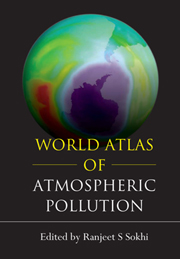Book contents
- Frontmatter
- Contents
- Contributors
- Foreword
- Preface
- Acknowledgements
- International Union of Air Pollution Prevention and Environmental Protection Associations (IUAPPA)
- Global Atmospheric Pollution (GAP) Forum
- Acronyms and Abbreviations
- Selected Units Used in Atmospheric Pollution Science
- INTRODUCTION
- CHAPTER 1 AIR POLLUTION HISTORY
- CHAPTER 2 AIR POLLUTION IN URBAN AREAS
- CHAPTER 3 LONG-RANGE TRANSPORT OF ATMOSPHERIC POLLUTANTS AND TRANSBOUNDARY POLLUTION
- CHAPTER 4 GLOBAL AIR POLLUTION AND CLIMATE CHANGE
- CHAPTER 5 OZONE DEPLETION
- CHAPTER 6 ENVIRONMENTAL AND HEALTH IMPACTS OF AIR POLLUTION
- CHAPTER 7 FUTURE TRENDS IN AIR POLLUTION
- References
- List of Useful Reading Material
- Index
CHAPTER 6 - ENVIRONMENTAL AND HEALTH IMPACTS OF AIR POLLUTION
Published online by Cambridge University Press: 05 March 2012
- Frontmatter
- Contents
- Contributors
- Foreword
- Preface
- Acknowledgements
- International Union of Air Pollution Prevention and Environmental Protection Associations (IUAPPA)
- Global Atmospheric Pollution (GAP) Forum
- Acronyms and Abbreviations
- Selected Units Used in Atmospheric Pollution Science
- INTRODUCTION
- CHAPTER 1 AIR POLLUTION HISTORY
- CHAPTER 2 AIR POLLUTION IN URBAN AREAS
- CHAPTER 3 LONG-RANGE TRANSPORT OF ATMOSPHERIC POLLUTANTS AND TRANSBOUNDARY POLLUTION
- CHAPTER 4 GLOBAL AIR POLLUTION AND CLIMATE CHANGE
- CHAPTER 5 OZONE DEPLETION
- CHAPTER 6 ENVIRONMENTAL AND HEALTH IMPACTS OF AIR POLLUTION
- CHAPTER 7 FUTURE TRENDS IN AIR POLLUTION
- References
- List of Useful Reading Material
- Index
Summary
Air pollution is known to have a range of effects, including those on human health, crop production, soil acidification, visibility and corrosion of materials. This Chapter focuses on the two major impacts of air pollution that have most strongly influenced the development of policies to reduce emissions: those on the natural environment and on human health.
In broad terms, the major impacts of air pollution on the natural environment can be placed into three categories, representing different spatial scales:
Local impacts of major industrial or urban sources, for example, instances of damage to ecosystems and crop production close to emission sources. Historically, the biggest impacts have been through the direct effects of sulphur dioxide and particles – either around large point sources such as power stations and smelters, or in urban areas with domestic coal burning – and the accumulation of toxic metals in soils around smelters. However, a range of other pollutants from specific local sources can have direct impacts on vegetation.
Regional impacts of ozone, which is a significant global air pollutant in terms of impacts on vegetation, since high concentrations are found in rural areas.
Regional impacts of long-Range Transport and deposition of sulphur and nitrogen, which have effects on soil acidity, nutrient availability and water chemistry, and hence on ecosystem composition and function.
The Chapter first considers direct effects of air pollution on vegetation and the visible symptoms of damage that can result, illustrating the spatial variation in damage by reference to national and local studies in the Netherlands.
- Type
- Chapter
- Information
- World Atlas of Atmospheric Pollution , pp. 77 - 94Publisher: Anthem PressPrint publication year: 2008
- 2
- Cited by



